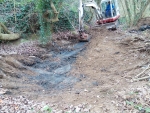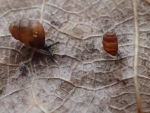-
21/11/2017
Research article in the journal Acta Zoologica Bulgarica by Ramon Mascort i Joan Budó. It can be read in the attached document in pdf.
Saved under: Articles
-
10/07/2017
Iago Pérez Novo 1 4, Carles Feo 2, Quim Pou-Rovira 2, Teia Puigvert 3
1 Societat Catalana d’Herpetologia, Museu de Ciències Naturals de Barcelona. (Museu Blau), Plaça Leonardo da Vinci 4-5, 08019 Barcelona.
2 Consorci de l’Estany, Plaça dels Estudis,...
Saved under: Articles
-
22/11/2016
The temporary ponds are semiaquatic habitats characterized by alternating dry and wet phases, for its unique flora and fauna and a high fragility.
The disappearance of this type of fresh water habitat and the gradual consolidation of the river into a...
Saved under: Articles
-
06/07/2016
The European Pond Turtle (Emys orbicularis) is widely distributed in Europe but remains very fragmented and disparate populations. The gradual decline of this species has become very clear over the last twenty years and is now an endangered species.
...
Saved under: Articles
-
17/12/2015
Vertigo moulinsiana and Vertigo angustior are two species of Gender Vertigo present in the Iberian Peninsula, set out in Annex II to Directive 92/43/EEC of 21 May 1992 on the conservation of natural habitats and of wild fauna and flora, known as "Hab...
Saved under: Articles
-
06/07/2015
White-clawed Crayfish (Austropotamobius pallipes) are freshwater crustaceans that live in clear and oxygenated rivers. A few years ago they were widely distributed in the watersheds of the rivers of Catalonia and southern Europe. The introduction of ...
Saved under: Articles
-
01/12/2014
Naiads are freshwater mussels that live in semi-buried conditions at the bottom of rivers, streams, canals and ponds. They are filtering organisms that feed on suspended matter, so they are very sensitive to changes in water quality. They act as an i...
Saved under: Articles







0309.jpg?amplada-maxima=150&llargada-maxima=150)













